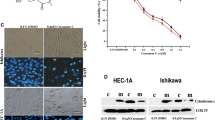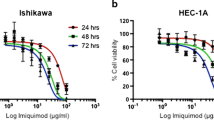Summary
The objective of the present study was to determine the in-vitro effect of Abietyl-Isothiocyanate (ABITC), a representative of a new class of anti-cancer drugs, on endometrial cancer (EC) cell lines. ABITC at concentrations ≥1 μM displayed dose-dependent and selective cytotoxicity to EC cell lines (ECC-1, AN3CA, RL95-2) in comparison to other cancer cell lines. After treatment with ABITC, ECC-1 unlike control cells displayed hallmark features of apoptosis including chromatin condensation and nuclear fragmentation. At concentrations below the IC50, ABITC exerted anti-proliferative effects by blocking cell-cycle progression through G0/G1 and S-phase. In addition, cells attempted to counteract drug treatment by pro-survival signaling such as deactivation of JNK/SAPK and p38 MAPK and activation of AKT and ErK1/2. ABITC also altered EGF-receptor phosphorylation. At a concentration of 5 μM ABITC generated an excess amount of reactive oxygen species (ROS) and displayed pro-apoptotic signaling such as activation of caspase-8, JNK-SAPK and deactivation of PARP-1. Co-treatment with an antioxidant blocked the drug effects by reducing ROS generation, cytotoxicity and pro-apoptotic signaling. In summary, novel isothiocyanate ABITC is an anti-proliferative and selectively cytotoxic drug to EC cells in-vitro. Key mechanisms during cell death are predominantly correlated to excess generation of ROS. We suggest the further development of ABITC as a potential therapeutic by studying the drug efficacy in EC in-vivo models.





Similar content being viewed by others
Abbreviations
- EC:
-
Endometrial cancer
- ABITC:
-
Abietyl-Isothiocyanate
- ITC:
-
Isothiocyanate
- ROS:
-
Reactive oxygen species
- MAPK:
-
Mitogen activated protein kinase
- FACS:
-
Fluorescent activated cell sorting
- EGF:
-
Epidermal growth factor
- DAPI:
-
4′-6-Diamidino-2-Phenylindole
References
American Cancer Society: Cancer Facts and Figures (2010) http://www.cancer.org
Creasman WT, Morrow CP, Bundy BN, Homesley HD, Graham JE, Heller PB (1987) Surgical pathologic spread patterns of endometrial cancer. A gynecologic oncology group study. Cancer 60:2035–2041
Thigpen JT, Brady MF, Homesley HD, Malfetano J, DuBeshter B, Burger RA, Liao S (2004) Phase III trial of doxorubicin with or without cisplatin in advanced endometrial carcinoma: a gynecologic oncology group study. J Clin Oncol 22:3902–3908
Hoskins PJ, Swenerton KD, Pike JA, Wong F, Lim P, Acquino-Parsons C, Lee N (2001) Paclitaxel and carboplatin, alone or with irradiation, in advanced or recurrent endometrial cancer: a phase II study. J Clin Oncol 19:4048–4053
Conaway CC, Yang Y, Lunk FC (2002) Isothiocynates as chemopreventive agents: their biological activities and metabolism in rodents and humans. Curr Drug Metab 3:233–255
Singh AV, Xiao D, Lew KL, Dhir R, Singh SV (2004) Sulforaphane induces caspase-mediated apoptosis in cultured PC-3 human prostate cancer cells and retards growth of PC-3 xenografts in vivo. Carcinogenesis 25:83–90
Singh SV, Herman-Antosiewicz A, Singh AV, Lew KL, Srivastava SK, Kamath R, Brown KD, Zhang L, Baskaran R (2004) Sulforaphane-induced G2/M phase cell-cycle arrest involves checkpoint kinase 2-mediated phosphorylation of cell division cycle. J Biol Chem 279:25813–25822
Jackson SJ, Singletary KW, Venema RC (2007) Sulforaphane suppresses angiogenesis and disrupts endothelial mitotic progression and microtubule polymerization. Vasc Pharmacol 46:77–84
Xiao D, Singh SV (2007) Phenethyl isothiocyanate inhibits angiogenesis in vitro and ex vivo. Cancer Res 67:2239–2246
Barecki RM, Wang EJ, Johnson WW (2003) Quantitative evaluation of isothiocyanates as substrates and inhibitors of P-glycoprotein. J Pharm Pharmacol 55:1251–1257
Tseng E, Kamath A, Morris ME (2002) Effect of organic isothiocyanates on the P-glycoprotein- and MRP1-mediated transport of daunomycin and vinblastine. Pharm Res 19:1509–1515
Singh RK, Lange TS, Kim K, Zou Y, Lieb C, Sholler GL, Brard L (2007) Effect of indole ethyl isothiocyanates on proliferation, apoptosis and MAPK signaling in neuroblastoma cell lines. Bioorg Med Chem Lett 17:5846–5852
Brard L, Singh RK, Kim KK, Lange TS, Sholler GS (2009) Induction of cytotoxicity, apoptosis and cell-cycle arrest by 1-t-butyl carbamoyl, 7-methyl-indole-3-ethyl isothiocyanate (NB7M) in nervous system cancer cells. Drug Des Dev Ther 2:61–69
Singh RK, Lange TS, Kim KK, Singh AP, Vorsa N, Brard L (2008) Isothiocyanate NB7M causes selective cytotoxicity, pro-apoptotic signaling and cell-cycle regression in ovarian cancer cells. Brit J Cancer 99:1823–1831
Singh RK, Lange TS, Shaw S, Kim KK, Brard L (2008) A novel Indole Ethyl Isothiocyanate (7Me-IEITC) with anti-proliferative and pro-apoptotic effects on platinum-resistant ovarian cancer cells. Gynecol Oncol 109:240–249
Bodo J, Hunakova L, Kvasnicka P, Jakubikova J, Duraj J, Kasparkova J, Sedlak J (2006) Sensitisation for cisplatin-induced apoptosis by isothiocyanate E-4IB leads to signalling pathways alterations. Br J Cancer 95:1348–1353
Lange TS, Kim KK, Singh RK, Strongin RM, McCourt CK, Brard L (2008) Iron(III)-salophene: an metallo-organic compound with selective cytotoxic and anti-proliferative properties in platinum-resistant ovarian cancer cells. PLOS One 3(5):e2303
Lange TS, Singh RK, Kim KK, Zou Y, Kalkunte SS, Sholler GL, Swamy N, Brard L (2007) Anti-proliferative and pro-apoptotic properties of 3-bromoacetoxy calcidiol (B3CD) in high-risk Neuroblastoma. Chem Biol Drug Des 70:302–310
Malich G, Markovic B, Winder C (1997) The sensitivity and specificity of the MTS tetrazolium assay for detecting the in vitro cytotoxicity of 20 chemicals using human cell lines. Toxicol 124:179–192
Albitar L, Pickett G, Morgan M, Wilken JA, Maihle NJ, Leslie KK (2010) EGFR isoforms and gene regulation in human endometrial cancer cells. Mol Cancer 9:166–179
Chen Q, Espey MG, Sun AY, Pooput C, Kirk KL, Krishna MC, Khosh DB, Drisko J, Levine M (2008) Pharmacologic doses of ascorbate act as a prooxidant and decrease growth of aggressive tumor xenografts in mice. Proc Natl Acad Sci USA 105:11105–11109
Morse MA, Eklind KI, Hecht SS, Jordan KG, Choi CI, Desai DH, Amin SG, Chung FL (1991) Structure-activity relationships for inhibition of 4-(methylnitrosamino)-1-(3-pyridyl)-1-butanone lung tumorigenesis by arylalkyl isothiocyanates in A/J mice. Cancer Res 51:1846–1850
Muftic M (1970) Essay on antibiotic properties of abietyl compounds. Pharm Biol 10:1601–1607
Lewis MP, Clements M, Takeda S, Kirby PL, Seki H, Lonsdale LB, Sullivan MH, Elder MG, White JO (1996) Partial characterization of an immortalized human trophoblast cell-line, TCL-1, which possesses a CSF-1 autocrine loop. Placenta 17:137–146
Hartwell LH, Kastan MB (1994) Cell-cycle control and cancer. Science 266:1821–1828
Gladden AB, Diehl JA (2003) Cell-cycle progression without cyclin E/CDK2: breaking down the walls of dogma. Cancer Cell 4:160–162
Aggarwal P, Lessie MD, Lin DI, Pontano L, Gladden AB, Nuskey B, Goradia A, Wasik MA, Klein-Szanto AJ, Rustgi AK, Bassing CH, Diehl JA (2007) Nuclear accumulation of cyclin D1 during S phase inhibits Cul4-dependent Cdt1 proteolysis and triggers p53-dependent DNA rereplication. Genes Dev 21:2908–2922
Pines J (1999) Four-dimensional control of the cell-cycle. Nat Cell Biol 1:73–79
Stillman B (1996) Cell-cycle control of DNA replication. Science 274:1659–1664
Shapiro GI, Harper JW (1999) Anticancer drug targets: cell-cycle and checkpoint control. J Clin Invest 104:1645–1653
Mazumder S, DuPree EL, Almasan A (2004) A dual role of cyclin E in cell proliferation and apoptosis may provide a target for cancer therapy. Curr Cancer Drug Targets 4:65–75
Pearson G, Robinson F, Beers GT, Xu BE, Karandikar M, Berman K, Cobb MH (2001) Mitogen-activated protein (MAP) kinase pathways: regulation and physiological functions. Endocr Rev 22:153–183
Birkenkamp KU, Dokter WH, Esselink MT, Jonk LJ, Kruijer W, Vellenga E (1999) A dual function for p38 MAP kinase in hematopoietic cells: involvement in apoptosis and cell activation. Leukemia 13:1037–1045
Ahmed-Choudhury J, Williams KT, Young LS, Adams DH, Afford SC (2006) SCCD40 mediated human cholangiocyte apoptosis requires JAK2 dependent activation of STAT3 in addition to activation of JNK1/2 and ERK1/2. Cell Signal 18:456–468
Cowley S, Paterson H, Kemp P, Marshall CJ (1994) Activation of MAP kinase kinase is necessary and sufficient for PC12 differentiation and for transformation of NIH 3T3 cells. Cell 77:841–852
Nicholson KM, Anderson NG (2002) The protein kinase B/Akt signaling pathway in human malignancy. Cell Signal 14:381–395
Kip A, West S, Sianna C, Dennis PA (2002) Activation of the PI3K/Akt pathway and chemotherapeutic resistance. Drug Resist Updat 5:234–248
Block M, Fister S, Emons G, Seeber S, Gründker C, Günthert AR (2010) Antiproliferative effects of antiestrogens and inhibitors of growth factor receptor signaling on endometrial cancer cells. Anticancer Res 30:2025–2031
Zhihong Ai Z, Yin L, Zhou X, Zhu Y, Zhu D, Yu Y, Feng Y (2006) Inhibition of surviving reduces cell proliferation and induces apoptosis in human endometrial cancer. Cancer 107(4):746–7561
Ai Z, Wang J, Wang Y, Lu L, Tong J, Teng Y (2010) Overexpressed epidermal growth factor receptor (EGFR)-induced progestin insensitivity in human endometrial carcinoma cells by the EGFR/mitogen-activated protein kinase signaling pathway. Cancer 116:3603–3613
Waris G, Ahsan HJ (2006) Reactive oxygen species: role in the development of cancer and various chronic conditions. Carcinogenesis 5:1–8
Gupte A, Mumper RJ (2009) Elevated copper and oxidative stress in cancer cells as a target for cancer treatment. Cancer Treat Rev 35:32–46
Hileman EO, Liu J, Albitar M, Keating MJ, Huang P (2004) Intrinsic oxidative stress in cancer cells: a biochemical basis for therapeutic selectivity. Cancer Chemother Pharmacol 53:209–219
Trachootham D, Alexandre J, Huang P (2009) Targeting cancer cells by ROS-mediated mechanisms: a radical therapeutic approach? Nat Rev Drug Discov 8:579–591
Osone S, Hosoi H, Kuwahara Y, Matsumoto Y, Lehara T, Sugimoto T (2004) Fenretinide induces sustained-activation of JNK/p38 MAPK and apoptosis in a reactive oxygen species-dependent manner in neuroblastoma cells. Int J Cancer 112:219–224
Kang YH, Lee SJ (2008) The role of p38 MAPK and JNK in Arsenic trioxide-induced mitochondrial cell death in human cervical cancer cells. J Cell Physiol 217:23–33
Mansat-de Mas V, Bezombes C, Quillet-Mary A, Bettaïeb A, D’orgeix AD, Laurent G, Jaffrézou JP (1999) Implication of radical oxygen species in ceramide generation, c-Jun N-terminal kinase activation and apoptosis induced by daunorubicin. Mol Pharmacol 56:867–874
Kim JS, Lee JH, Jeong WW, Choi DH, Cha HJ, do Kim H, Kwon JK, Park SE, Park JH, Cho HR, Lee SH, Park SK, Lee BJ, Min YJ, Park JW (2008) Reactive oxygen species-dependent EndoG release mediates cisplatin-induced caspase-independent apoptosis in human head and neck squamous carcinoma cells. Int J Cancer 122:672–680
Tsai-Turton M, Luong BT, Tan Y, Luderer U (2007) Cyclophosphamide-induced apoptosis in COV434 human granulosa cells involves oxidative stress and glutathione depletion. Toxicol Sci 98:216–230
Acknowledgements
RGM is partially supported by NCI Grant #1 RO1 CA136491-01 and Grants from Swim Across America. The authors thank Dr. R. K. Singh for design of compound Abietyl-Isothiocyanate.
Author information
Authors and Affiliations
Corresponding author
Rights and permissions
About this article
Cite this article
Horan, T.C., Zompa, M.A., Seto, C.T. et al. Description of the cytotoxic effect of a novel drug Abietyl-Isothiocyanate on endometrial cancer cell lines. Invest New Drugs 30, 1460–1470 (2012). https://doi.org/10.1007/s10637-011-9728-z
Received:
Accepted:
Published:
Issue Date:
DOI: https://doi.org/10.1007/s10637-011-9728-z




